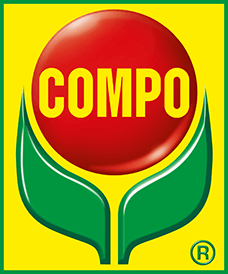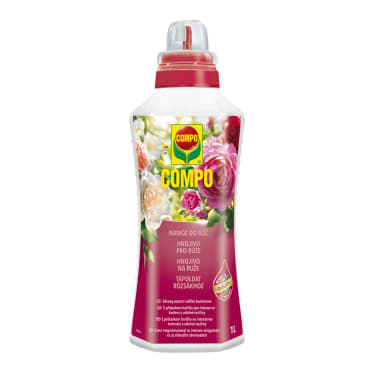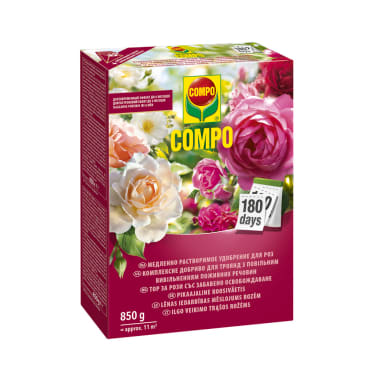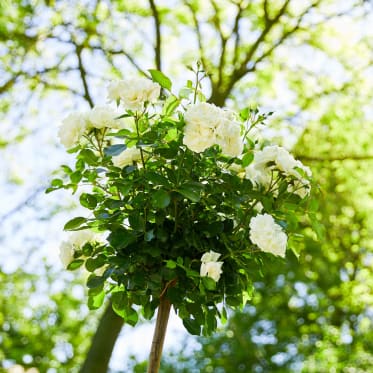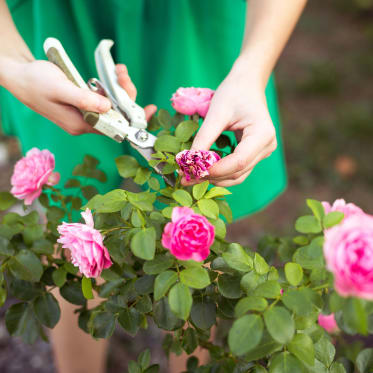Frequent search terms

- COMPO
- Guide
- Plant Care
- Garden
- Roses
- Fertilising roses properly
Fertilising roses
That hardly any other shrub bears so many colourful flower heads – some from May to September – is one good reason why roses will probably never go out of fashion! But what impresses the gardener costs the plant a lot of energy. For your rose to be able to keep this up, ideally over many decades, it will need plenty of nutrients. We reveal when, how and what you should use to fertilise your roses properly – for the enjoyment of strong flowers and plants.

Spring and summer
How often do roses need to be fertilised?
Because of their high nutrient requirements, you should always fertilise roses in the spring before the growing phase. The nutrients contained in rose fertiliser ensure strong growth, an abundance of flowers and strengthen the ability to ward off pests and disease. The perfect time for the first fertilisation depends strongly on the weather. Roses usually awaken from their winter slumber in late March or early April and should be fertilised when the first buds start to sprout at the latest. For repeat-flowering rose varieties, a second fertilisation is recommended in late June or early July if appropriate.
First fertilisation in early April
Fertilising roses in the spring
For roses to grow vigorously and bloom abundantly after spring pruning, they need light and water, as well as an appropriate supply of nutrients. To promote new shoots and floral development, nitrogen and phosphorus are especially important during this period. You can choose between organic, mineral or organo-mineral fertiliser as a combination solution.
What should you fertilise roses with in the spring?
Fast acting
Mineral fertilisation

Mineral rose fertilisers contain the most important nutrients in the form of easily soluble minerals and fertiliser salts. They dissolve into the soil moisture and are thus immediately available to the plants. This makes it possible to optimally cover the immediate needs of a plant and acute nutrient deficiencies can be quickly remedied.
In the case of mineral slow-release fertilisers, the fertiliser beads are coated with a layer of resin. The nutrients penetrate the coating in harmony with natural growth factors (moisture and soil temperature) and are released as needed. By combining both technologies, our company’s mineral slow-release rose fertiliser ensures that roses receive an optimum supply of nutrients over six months from the very first day. This prevents under/over-fertilisation and loss of nutrients (leaching). And you protect the environment at the same time.
Ensure sufficient watering after fertilisation
After fertilisation sufficient watering is necessary, as this is the only way to get the nutrients to the roots quickly. To allow the fertiliser to develop its full effect check the moisture of the soil regularly after fertilising.

For repeat-flowering rose varieties
Fertilising roses in the summer
Most of the roses in your borders will flower several times a year. If they are cut back in the summer after the first flowering period, a second flush will form. These so-called repeat-flowering roses need a lot of nutrients to develop buds again. Most fertilisers guarantee effectiveness for up to three months, so a second fertilisation at the end of June is recommended to meet the nutrient requirements during the second flowering period.
Since summer fertilisation should take effect as quickly as possible, the use of a mineral fertiliser with a short duration of effectiveness and high potassium content is ideal (e.g. potash fertiliser). It is important to ensure that you do not use too much fertiliser during the second application because the new shoots that the rose produces in the summer are still very tender at the beginning and sufficient time is needed for them to develop the necessary frost hardiness by the winter. Therefore, do not fertilise bed roses too late – you should apply the last nitrogen fertiliser by mid-July at the latest.
Mineral slow-release fertilisers like the COMPO slow-release fertiliser for roses are the right choice for anyone who only wants to fertilise roses in a container once a season. It supplies the queen of flowers with all the important main and trace nutrients as needed over several months. For optimum effect the slow-release rose fertiliser should be spread evenly, worked lightly into the soil and then kept consistently moist.

Risk of frost damage
Fertilising roses in the autumn
Roses should not be fertilised with a nitrogen fertiliser from August onwards. Although additional nutrients – and especially the nitrogen contained in them – would promote the growth of new shoots, they would not have enough time to mature before the winter. These soft shoots freeze in frosty temperatures, weakening the roses and making them more susceptible to pathogens and pests in the process.

Mineral nutrient supply
Fertilising roses in tubs and pots
Roses in a container only have a limited amount of soil available, so needs-based fertilisation is especially important so as to meet their high nutrient demand. Since soil fauna in addition to space is limited in pots and tubs, we recommend the use of a mineral fertiliser.
You can add a mineral liquid fertiliser to the water once or twice a week during the growing phase. Since this type of fertiliser contains mineral salts, the soil in the pot should not dry out completely immediately after watering because these salts can then attack the roots of your rose, meaning it is advisable to add a little clear water every day when it’s 30 °C and sunny.
By the way
Due to its rapid effectiveness, a mineral liquid fertiliser is also ideal for treating acute nutrient deficiencies – even for bed roses.
Suitable products for rose care
More information on the subject of roses
